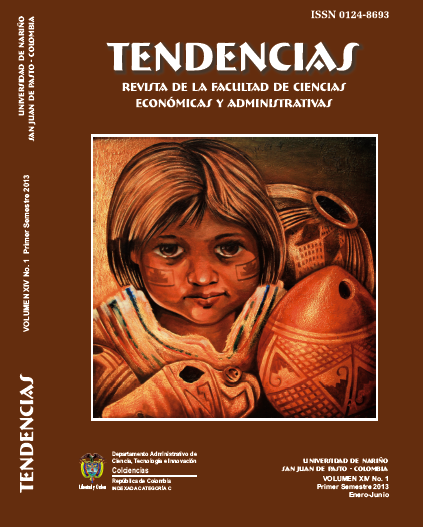Teoría de la complejidad y aplicaciones a la administración: principios sobre la coherencia y la fluidez de sistemas operativos en las empresas
Palavras-chave:
teoría de la complejidad, dirección empresarial, flujo de operaciones logísticasResumo
El objetivo fundamental de artículo es discutir la importancia y puesta en práctica de mecanismos operativos relacionados con: (i) coherencia en la dirección de política empresarial; y (ii) de mantenimiento de los flujos de operaciones dentro de las organizaciones o empresas. Se abordan inicialmente aspectos esenciales de la teoría de la complejidad. A partir de ellos se determinan directrices para operativizar los principios y prácticas antes referidos. La teoría de la complejidad puede brindar elementos muy valiosos para la planeación, organización, dotación de recursos, operativización y control de las actividades de empresas o unidades de producción.
Downloads
Referências
Axelrod R.M. (1997). The complexity of cooperation. Princeton: Princeton University Press.
Barzun, J. (2008). From Dawn to Decadence. New York: Harper Collins.
Berwick D.M. (1998). Developing and testing changes in delivery of care. Ann Intern Med. 1998;128:651– 656.
Bourne, L. (January 2007). Avoiding the Successful Failure. PMI Global Congress Asia-Paci!c, Hong
Briggs J. (1992). Fractals: the patterns of chaos. New York: Simon & Schuster.
Brookes N.J. Morton S.C. Dainty A.R.J. Burns N.D. (2006). Social processes, patterns and practices and project knowledge management: A theoretical framework and empirical investigation. International Journal of Project Management 24, 474-482.
Cooke-Davies, T., Cicmil, S., Crawford, L., Richardson, K. (2007). We’re Not In Kansa Anymore, Toto:Mapping the Strange Landscape of Complexity Theory, and its Relationship to Project Management. Project Management Journal, Vol 38, No. 2, 50-61
Day, Richard (2004). The Divergent Dynamics of Economic Growth. Nueva York: Cambridge University Press.
Diesing, Paul. (2009). How does Social Science Work? Re!ections on Practice. Pittsburgh, Pennsylvania: University of Pittsburgh Press.
Dubin R. (1978). Theory Building. Free Press, New York.
Echeverría, Rubén (2001). Desarrollo de las Economías Rurales de América Latina. Washington, D.C.: Banco Interamericano de Desarrollo.
Gell-Mann M. (1995). The quark and the jaguar: adventures in the simple and complex. New York: Freeman.
Goldberger A.L. (1996). Nonlinear dynamics for clinicians: chaos theory, fractals, and complexity at the bedside. Lancet. 1996;347:1312–1314.
Hansen, B.C. (1999). The metabolic syndrome X. Ann N Y Acad Sci. 1999;892:1–24.
Helliner, G. (2004). Outward orientation, import instability and African economic growth: an empirical investigation in Theory and reality in development. London: McMillan.
Holland J.H. (1995). Hidden order: how adaptation builds complexity. Reading, MA: Addison-Wesley.
Hurst D, Zimmerman B.J. (1994). From life cycle to ecocycle: a new perspective on the growth, maturity, destruction, and renewal of complex systems. J Manage Inquiry. 1994;3:339–354.
Johnson, Harold (2004). Trade Strategy for Rich and Poor Nations. Toronto: University of Toronto Press.
Kolb D.A. (1984). Experiential learning. Experience as the source of learning and development. Englewood Cli#s, NJ: Prentice Hall.
Koontz, H. & Weihrich, H. (2012). Administración: Una Perspectiva Global. México: McGraw-Hill.
Langton C.G. (1989). Arti!cial life. Proceedings of the Santa Fe Institute. Studies in the sciences of complexity. Vol. 6. Redwood City, CA: Addison-Wesley.
Lorenz E. (1993). The essence of chaos. Seattle: University of Washington Press.
Malloch, Thomas (2007). Issues in International Trade and Development Policy. Wesport: Greenwood Press. Management 25, 266-274.
Mandelbrot B. (1999). A fractal walk on Wall Street. Sci Am. 1999;280(2):70–73.
Mochon Francisco (2007). Microeconomia. Madrid: McGraw-Hill.
Morgan G. (1997). Images of organization. 2nd ed. Thousand Oaks, CA: Sage.
Pollak J. (2007). The changing paradigms of project management. International Journal of Project
Portes, Alejandro (2007). Las Instituciones en el Desarrollo Latinoamericano. México, D.F., México: Siglo XXI editores.
Rasiah, Rajah (2009). Uneven Paths of Development.Northampton, Massachusetts: William Pratt House.
Restrepo, F. & Rivera, H. (2008) Análisis Estructural de Sectores Estratégicos. Bogotá, Colombia: Universidad del Rosario.
Roberts M. (1998). Modern Management Systems for Higher Margins. Proceedings, Micro Planning
Schafer R. (1976). A new language for psychoanalysis. New Haven, CT: Yale University Press.
Schon D.A. (1983). The re#ective practitioner. New York: Basic Books; 1983.
Sharp L.F, Piesmeyer H.R. (1995). Chaos theory: a primer for health care. Quality management in healthcare. 1995;3(4):71–86.
Stacey R.D. (1996). Strategic management and organizational dynamics. London: Pitman Publishing.
Stich S.P. (1990). Rationality. In: Osherson DN, Smith EE, editors. An invitation to cognitive science: thinking. Vol. 3. Cambridge, MA: MIT Press.
Thamheim J. (2007). Managing Project Teams in an Age of Complexity. Proceedings, PMI Global
Todaro, Michael (2005). Economic Development in the Third World. New York: Longman.
Varela F, Coutinho A. (1991). Second generation immune networks. Immunol Today. 1991;12(5):159–166.
Waldrop M.W. (1992). Complexity: the emerging science at the edge of order and chaos. New York: Simon and Schuster.
Watson, P. (2011). Historia de las Ideas. Bogotá, Colombia: Taurus.
Watson, P. (2010). Historia Intelectual del Siglo XX. Bogotá, Colombia: Taurus.
Wilson E.O. (1971). The insect societies. Cambridge, MA: Harvard University Press.
Wilson T, Holt T, Greenhalgh T. (2003). Complexity and clinical care. Nueva York: Random
Zimmerman B.J, Lindberg C, Plsek P.E. (1998). Edgeware: complexity resources for healthcare leaders. Irving, TX: VHA Publishing.
Publicado
Como Citar
Edição
Seção
Licença
Aquellos autores/as que tengan publicaciones con esta revista, aceptan los términos siguientes:
Esta revista está bajo una Licencia Creative Commons Reconocimiento-NoComercial 4.0 Internacional License. Los artículos se pueden copiar, distribuir, adaptar y comunicar públicamente, siempre y cuando se reconozcan los créditos de la obra y se cite la respectiva fuente. Esta obra no puede ser utilizada con fines comerciales.
Para aumentar su visibilidad, los documentos se envían a bases de datos y sistemas de indización.
El contenido de los artículos es responsabilidad de cada autor y no compromete, de ninguna manera, a la revista o a la institución.







































